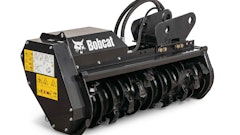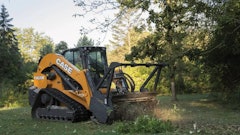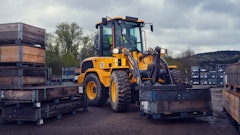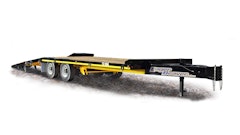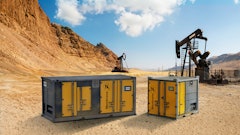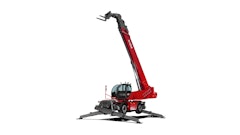
By Larry Trojak
Information from this article was first published in Demolition Magazine and is being reused with permission from the National Demolition Association.
To be successful, demolition contractors must possess a skill set that allows them to identify and solve unusual challenges. Such challenges can include close proximity to active areas or other structures, the need to demo a section of a building while its business remains operational and heights that exceed the reach of most standard equipment. On a project in downtown St. Paul, Minnesota, NDA member Rachel Contracting has hit the demolition trifecta: It’s bringing down a massive 700,000-square-foot complex of structures that was not only built into a bluff but also faces a pair of busy St. Paul thoroughfares and, in places, is just steps from an active rail line. To address all these concerns, the company is utilizing the strength and versatility of a range of machinery and attachments, including a newly designed tool from Genesis Attachments.
Prime real estate
The former West Publishing headquarters, built in 1886, and the Ramsey County Adult Detention Center (ADC), built in 1979, were mainstays of the St. Paul riverfront landscape. Sitting on 3.9 acres, the seven-structure complex had outlived its usefulness when West relocated to a suburb, and the jail was quickly deemed inadequate. Repeated efforts to sell the property were hindered by the daunting thought of demolishing the existing structures, which rise up to 10 stories from the base of a riverside bluff, and years of on-again, off-again government tenants that finally led to the entire complex sitting vacant for the last several years. Recognizing the property’s tax revenue potential, Ramsey County committed to undertaking the demolition and, when the bidding process was complete, St. Michael, MN-based Rachel Contracting had the job.
The eight-story ADC was the first structure slated to come down. Work on it started in August 2015 with interior demolition, according to Mark Kraemer, Rachel’s vice president of field operations.
“The interior work included asbestos abatement, followed by removal of any remaining hazardous materials as well as municipal solid waste and other debris,” he says. “What makes this job different from most others, however, is the fact that the structures are essentially built right into the side of a bluff alongside the Mississippi River. So, with the preliminary interior work completed, we moved into a bluff stabilization phase. For that, we had crews core-drill into the back wall of the building, install 40-foot threaded rods, and inject each core with grout to secure the structure to the bluff during demolition. Once demo is complete, a new concrete wall will be built and backfilled to keep the bluff face intact and ready for new construction.”
Upwardly productive
The height of the structures, more than 90 feet in most areas, coupled with their proximity to active pedestrian, vehicle and train traffic, eliminated the use of any of the more traditional demolition techniques, such as implosion or a wrecking ball. The alternative, a high-reach excavator outfitted with a GDT Razer 290 from Genesis Attachments, fit the bill perfectly, Kraemer says.
“We have the GDT mounted on a Volvo EC700C HR, a 195,000-pound base machine with the high-reach package,” he says. “That configuration affords us just over 105 feet of reach, more than enough for even the uppermost reaches of the ADC structure. Our options were definitely limited by our surroundings. An active Amtrak line runs as close as 25 feet to one side of the jail, and one corner of the structure is just feet from the heavily traveled Wabasha Street Bridge.”
Material encountered during the ADC portion of the demo included 10-inch-thick two-way concrete slabs reinforced with #4 rebar at 10 inches on center each way. The structure also included a parking garage that had 12-inch concrete slabs.
“We also processed 1.5 foot square reinforced concrete columns, and concrete waffle slabs measuring 12 inches deep, with a 19-inch dome, 5-inch-wide ribs and a 3 5/8-inch topping slab,” Kraemer says.
As the project continues, the company will eventually be far enough into the structure that it will be at street level and facing Kellogg Avenue, a major east-west artery in downtown St. Paul, and still another logistical challenge. Remaining highly controlled in every aspect of the demolition process, says Kraemer, has not only been key to production, it’s helped ensure a safe operation.
Invaluable control
At 7,000 pounds, the GDT Razer is light enough to be very maneuverable, even at peak heights, yet still provide the power needed for effective concrete cracking. According to Rachel’s project superintendent, Jim Jude, that maneuverability is being put to the test on the ADC facet of the job.
“The jail’s overall footprint is a strange zig-zag shape, but the interior of the structure also has hallways and walls that seem to run in every direction,” he says. “Through a combination of the attachment’s rotation and its design, the GDT Razer is able to easily access every area we need to get at, then crack and drop the concrete material. It will also be great to have that degree of control when we are at the part of the structure where the tie-backs are present. Being able to trim in these areas without fear of messing with the tie-backs will be a real plus.”
For added versatility, the number and location of crushing teeth on the GDT Razer can be customized to meet Rachel’s project needs. In addition, the bolt-on teeth can be interchanged and reversed front to back, increasing their life and lowering the cost of operation. Jude says the position of the pin centers on the tool make it easier for him to roll it back to get under a beam. “That alone has helped keep things moving out here.”
The rest of the cast
While the GDT Razer has four-way indexable blades for cutting any rebar encountered in the structures, the bulk of the actual material processing is being done using a combination of additional Genesis tools. These include an LXP 300 Logix Processor and a GDR 300 Demolition Recycler, each mounted on a Cat 336E; and a Demo Pro 900 on a Cat 349.
“The other attachments will be pulling double-duty on this project,” Kraemer says. “In addition to processing the more than 100,000 tons of concrete and brick we expect to encounter here, they will also be doing actual demolition on some of the lower, more accessible areas of these structures. We like that they are multifaceted in what they can do and use it to our advantage whenever possible.”
Kraemer says Rachel Contracting’s relationship with Genesis extends back about eight years and, while the company obviously appreciates the job the tools do, the commitment centers around service and support. “We like that Genesis is always there when we need them, treats us well and keeps us in the loop with new developments as they arise,” Kraemer says. “They have the whole package, and we like that.”
Beyond the jail
The St. Paul project includes far more than just the Ramsey County Jail. Next on the list is the one-time West Publishing complex of buildings, now called the Ramsey County Government Center (RCGC). The RCGC sits adjacent to the jail, is roughly three times its size and presents the same logistical challenges as the ADC.
“The RCGC complex represents the bulk of the 700,000 square feet of demolition,” Kraemer says. “And because it was added onto repeatedly in its 130-year history, there are different types of construction evident, some with much more structural steel, for example. However, because of who we are as a company and the way we approach projects like this, we are equipped to tackle anything we encounter.”
The demolition is slated for a spring 2017 completion.



